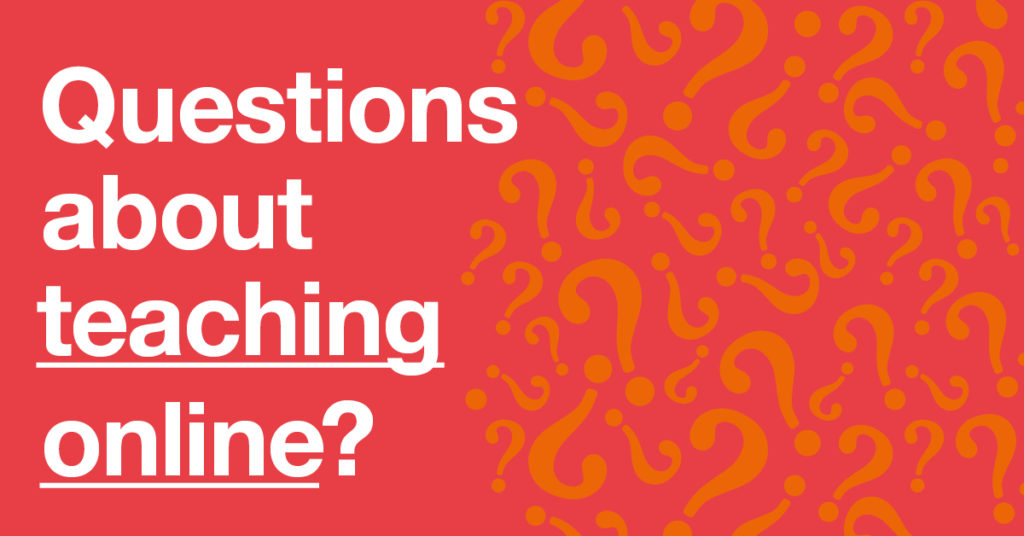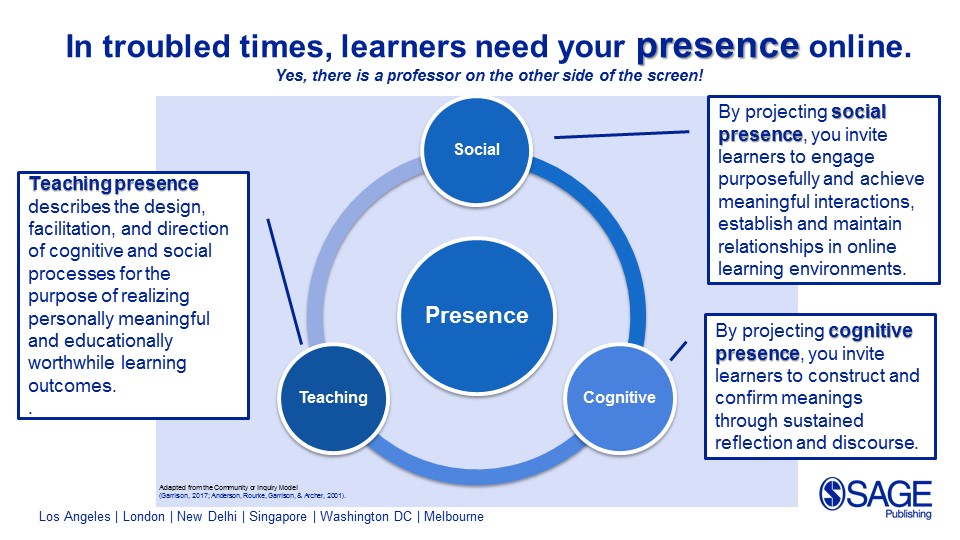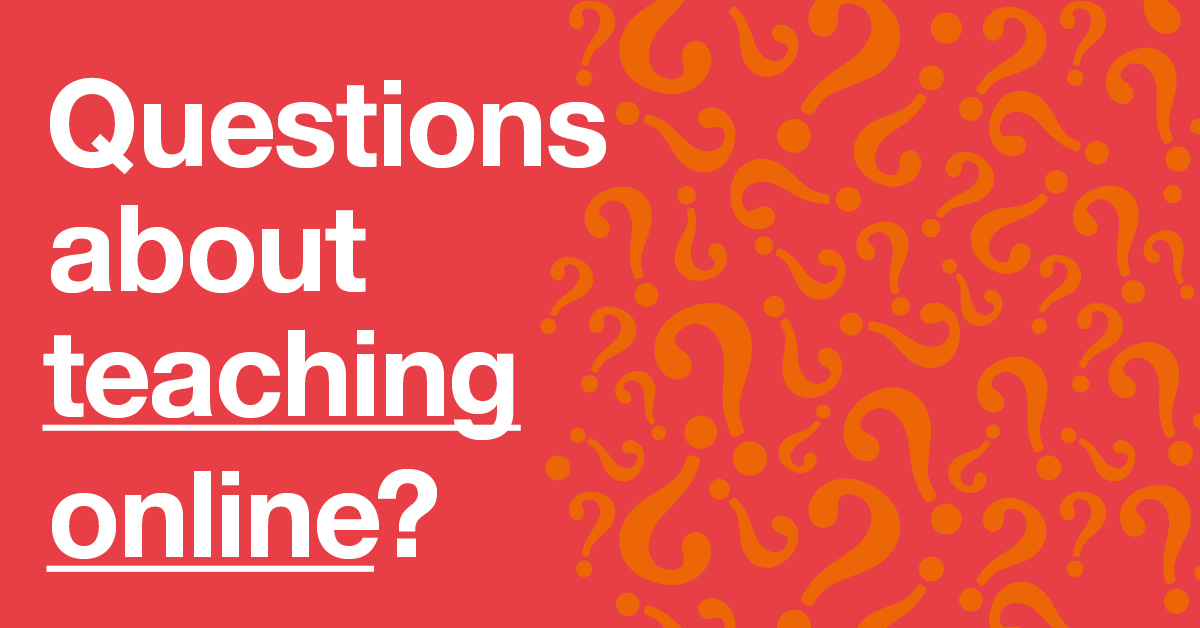16 Answers to Your Questions about Teaching Online

Free resources drawn from social and behavioral science
The call for ‘social distancing’ in the wake of the coronavirus and its attendant COVID-19 disease has seen schools and universities around the world hurriedly attempting to turn their physical classrooms into virtual ones. While this may be best immediate reaction from an epidemiological point of view, from a pedagogic perspective, it has left instructors desperately trying to retrofit and reformat their courses while trying not to unduly disadvantage large numbers of their students. As a means of supporting those attempting to do their best under trying circumstances, SAGE Publishing has drawn from its large body of published and peer-reviewed research to offer the resources below — free of charge — to serve teachers and students around the world.
Index:
The Basics
Meeting Student Needs
Meeting Course Requirements
Tools
Other Considerations

Editor’s Note: SAGE’s Methods Guru, Janet Salmons, has also drawn from SAGE’s large body of published research to create a resource for those who are making the switch to online classes. Rooted in theory, suggestions and resources can be found in the post here: ‘Making a Sudden Transition to Teaching Online: Suggestions and Resources.’
UPDATE: The journal TEACHING Exceptional Children‘s special issue on online learning for special education teachers has been opened for free access. Click here to read those papers.
The Basics
What is online learning and what can I expect compared to face-to-face situations?
“Research on Online Education,” by Daria S. LaFave from The SAGE Encyclopedia of Online Education edited by Steven L. Danver
This introduction to online education from 2016 provides an overview of the teaching landscape, sharing different research on the topic. The entry discusses how face-to-face and online environments compare, particularly with regards to learning outcomes, instructional design, and instructional effectiveness. Valuable insight is also shared on how to better understand online learners.
What are the different types of online learning? Which is best for my course?
“E-Learning and Blended Learning,” by Helen Ritchie from Storytelling, part of the SAGE Video collection
There are different ways to structure an online course: an instructor can let students review materials on their own time, use video conferencing to livestream a lecture, or implement hands-on “classroom” sessions. This video discusses different approaches and how they can be combined.
How do I adapt a face-to-face course to online?
“Lost in Translation: Adapting a Face-to-Face Course Into an Online Learning Experience,” by Melissa J. Kenzig in Health Promotion Practice, July 2015
Many instructors being asked to adapt their face-to-face courses to an online environment do not have sufficient training do so. This commentary shares challenges faced by instructors adapting courses from face-to-face to online, best practices, and common mistakes.
How do I motivate and engage in an online environment?
“A Practical Guide, With Theoretical Underpinnings, for Creating Effective Virtual Reality Learning Environments,” by Eileen A. O’Connor and Jelia Domingo in Journal of Educational Technology Systems, February 2017
Based on many years experience, the authors suggest educationally productive, research-supported ways to create learning environments that can motivate, engage, and educate participants in an online environment. Scroll down to the section titled “General Application” to find ideas related to “ice breakers” and community interactions, bringing in external speakers, virtual poster sessions, role playing, shared problem-solving, and more.
What are the other challenges related to online learning to be wary of?
“Issues and Challenges for Teaching Successful Online Courses in Higher Education: A Literature Review,” by Masureh Kebritchi, Angie Lipschuetx, and Lilia Santiague in Journal of Educational Technology Systems, August 2017
This article identifies the major issues related to online learning that instructors and institutions should be wary of such as:
- Learner issues: learners’ expectations, readiness, and participation
- Instructor issues: making the transition from face-to-face to online, managing time, and finding appropriate teaching styles
- Content issues: the role of instructors in content development, integration of multimedia, and the role of instructional strategies in content development
How can I ensure quality of participation?
“Student Participation,” by Jean A. Stuntz from The SAGE Encyclopedia of Online Education edited by Steven L. Danver
Participation in an online course calls for interaction with the materials, students, and the instructor. The entry digs into why intuitive communication and navigation is necessary for quality participation, as well as different hands-on and hands-off approaches for instructors to implement from the beginning.
How can I add the “human touch” and maintain student retention?
“Adding the Human Touch to Asynchronous Online Learning,” by Cynthia Wheatley Glenn in Journal of College Student Retention: Research, Theory & Practice, March 2016
This article shares ways to extend the “human touch” in an online environment in a way that will improve student retention (scroll down to the section “Variables that Improve Student Retention”).
How do I integrate small group work in online courses?
“Online Course Student Collaboration Literature: A Review and Critique,” by Maura R. Cherney, Michelle Fetherston, and Lauren Jean Johnsen in Small Group Research, August 2017
Through a meta-synthesis of 41 articles related to small group work in online courses, the article addresses questions about group size (what’s optimal?), assembling a group (how do I split up students?), assigning roles to group members, “free-riding” and more.
Meeting Student Needs
How can I understand what type of learner my student is in an online course?
“Learner-Centered Techniques,” by Terry Mackey from The SAGE Encyclopedia of Online Education edited by Steven L. Danver
Teaching an online course might require instructors to re-learn the individual preferences of each student. This entry goes over various tools instructors can use to gain that understanding, such as polls, surveys, and drawing tools, not only so that courses become student-centered, but also so student retention and skill increase.
How do I support students with emotional and behavioral disorders in an online environment?
“Teaching Online Social Skills to Students With Emotional and Behavioral Disorders,” by Joseph John Morgan, Kyle Giggins, Susan Miller, Thomas B. Pierce, Randall Boone, and Richard Tandy in Journal of Special Education Technology, May 2016
Technology use creates new natural environments for social participation and new rules for social interaction and it has been theorized that students with emotional and behavioral disorders will not do as well socially in online environments. This study studied different types of online social skill instruction and found that they were effective at increasing students’ identification of problem behaviors in an online environment. Implications for the incorporation of this instruction into social skills interventions are discussed.
How can I support diversity in an online environment?
“Respecting Diversity in an Online Environment,” by Robyn Trippany Simmons, Tiffany Rush-Wilson, and Breyan Haizlip from Online Counselor Education: A Guide for Students edited by Carl J. Sheperis and R.J. Davis
Understanding elements of diversity and how they may impact interaction in the online environment is critical. This chapter from a text published in 2016 helps both instructors and students become familiar with parameters for difficult discussions and potential microaggressions that can occur in an online environment.
How can I prepare students for the real world through online learning?
“Fostering Emotional Intelligence in Online Higher Education Courses,” by Robin Aa. Majeski in Adult Learning, September 2017
Many courses developed to prepare students for the real world have begun to help learners develop emotional intelligence competencies such as emotional self-control, conflict management, teamwork, cultural awareness, and inspirational leadership. This article proposes specific course design and instructional strategies that can foster emotional intelligence in an online learning environment.
Meeting Course Requirements
What if I still need my students to participate in service learning? How do I do that in an online environment?
“Facilitating Service Learning in the Online Technical Communication Classroom,” by Danielle Nielsen in Journal of Technical Writing and Communication, March 2016
Drawing from the author’s experience teaching online technical communication courses with a service-learning component, this article addresses courses where students are required to find service opportunities. The author argues that by implementing service learning into online classrooms and requiring students to locate their own opportunities, students not only build a greater sense of civic engagement because they also they develop a greater sense of responsibility for their own education and the coursework they undertake.
Tools
How can Slack complement online instruction?
“Slack It to Me: Complementing LMS With Student-Centric Communications for the Millennial/Post-Millennial Student,” by Spencer M. Ross in Journal of Marketing Education, February 2019
This article first assesses the attitudes and perceptions of widely used learning management systems (LMS) in creating an engaging student learning experience and then discusses the educational uses of Slack, a business communications tool, as an LMS complement. While many LMS platforms present communication challenges for students and instructors, the author finds that Slack positively enhances students’ perceptions of the classroom as a real-world experience, as well as perceived learning outcomes from group work.
Other Considerations
What about ethics in the online learning environment?
“Internet Ethics for Users and Providers,” by Marion G. Ben-Jacob in Journal of Educational Technology Systems, March 2017
While not focused specifically on online teaching, this article deliberates concepts of Internet ethics from the perspectives of user and providers. It discusses concerns of the users from different disciplines, addresses issues and regulations of service providers, and considers matters of privacy. It ends by sharing an exercise for students that promotes awareness of Internet ethics.




























































































Thank you for sharing this very informative article! Keep on posting
Though everything cannot be taught online, there is certainly a great value for teaching online. If there was no such option, then the education could have halted for 2 years. Thank you for the helpful answers to make it more effective.
Thank you for sharing this valuable information. I will definitely be implementing it in my classes from now on. I didn’t know that there are types of online education. I will be sharing this with my team.
Oh, thank you for this article. It was very interesting for me to read it. I run my own blog and will definitely mention some things from this article.
Keep on doing useful things further. I will be following your articles!
Informative write-up. Here are some ideas to make online teaching effective and simplify delivery of your virtual lessons.
I’ve been trying to learn this for so long but every time I try I lose interest because the content gets boring or confusing. You totally made me enjoy every bit of it! Thank you!!!
A very quick guide to configuring Zoom – with screenshots – from a privacy and security mindset may also be helpful.
There’s so much to do in going all virtual, I already put this guide together. Figured I might as well share it with others who care about student privacy but just don’t have time to attend to every little detail.
https://medium.com/@laura.noren/zoom-configurations-5-mins-for-privacy-and-security-29f1514b2e23